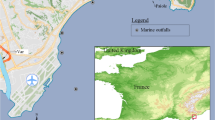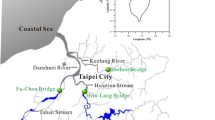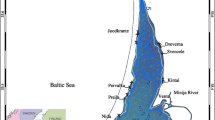Abstract
This study aims at understanding the fecal contamination behavior in a small coastal stream (Aljezur, Portugal), which has significant economic and ecological values. Like in most small coastal systems, circulation and water renewal in the Aljezur stream exhibit a strong variability due to their dependence on tides, waves, intermittent river flows, and a highly variable morphology. Hence, the problem was approached through a combination of field surveys and the development and application of a hard-coupled three-dimensional hydrodynamic and fecal contamination model. Salinity and temperature results have shown that mixing and transport in the stream are very sensitive to the river flow and wind forcing. The model is able to represent the main patterns and trends observed in Escherichia coli and fecal enterococcus concentrations along the stream, for different environmental and contamination conditions, suggesting die-off rates on the order of 0.50–0.55 day−1. Die-off rate and the representation of the sediment-associated processes were identified as the major remaining sources of uncertainty in the model. Results show that, owing to the processes that occur along the stream, fecal bacteria reach the beaches water in numbers that comply with the European Bathing Waters Directive, even during the summer periods when the upstream concentrations are larger. In particular, results suggest a direct relation between the tidal propagation upstream and the reduction of the fecal bacteria concentrations along the stream that can be relevant for the development of a strategy for the management of the system’s water safety.












Similar content being viewed by others
References
Alkan U, Elliot DJ, Evison LM (1995) Survival of enteric bacteria in relation to simulated solar radiation and other environmental factors in marine waters. Water Res 29(9):2071–2081. doi:10.1016/0043-1354(95)00021-C
Almeida et al. (2000) Plano de Bacia Hidrográfica das Ribeiras do Algarve, 1ª fase, volume III, Ministério do Ambiente e do Ordenamento do Território
Anderson KL, Whitlock JE, Harwood VJ (2005) Persistence and differential survival of fecal indicator bacteria in subtropical waters and sediments. Appl Environ Microbiol 71:3041–3048. doi:10.1128/AEM.71.6.3041-3048.2005
Azevedo A, Oliveira A, Fortunato AB, Bertin X (2009) Application of an Eulerian–Lagrangian oil spill modeling system to the Prestige accident: trajectory analysis. J Coast Res SI56:777–781
Bai S, Lung WS (2005) Modeling sediment impact on the transport of fecal bacteria. Water Res 39:5232–5240. doi:10.1016/j.watres.2005.10.013
Bisset WP, Walsh JJ, Dieterle DA, Carder KL (1998) Carbon cycling in the upper waters of the Sargasso Sea: I. Numerical simulation of differential carbon and nitrogen fluxes. Deep Sea Res I 46(2):205–269. doi:10.1016/S0967-0637(98)00062-4
Canteras JC, Juanes JA, Pérez L, Koev KN (1995) Modelling the coliforms inactivation rates in the Cantabrian Sea (Bay of Biscay) from in situ and laboratory determinations of T90. Wat Sc Tech 32:37–44. doi:10.1016/0273-1223(95)00567-7
Chigbu P, Gordon S, Strange TR (2005) Fecal coliform bacteria disappearance rates in a north-central Gulf of Mexico estuary. Estuar Coast Shelf S 65:309–318. doi:10.1016/j.ecss.2005.05.020
Colella P, Woodward PR (1984) The piecewise parabolic method (PPM) for gas-dynamical simulations. J Comput Phys 54:174–201
Cravo, A, Menaia, J, Napier, V, (2010) A qualidade da água da ribeira de Aljezur, SW Portugal: seus efeitos nas águas balneares. 14º ENaSB /SILUBESA Encontro Nacional de Saneamento Básico/Simpósio Luso-Brasileiro de Engenharia Sanitária e Ambiental (CD-Rom)
Davies CM, Long JAH, Donald M, Ashbolt NJ (1995) Survival of fecal microorganisms in marine and freshwater sediments. Appl Environ Microbiol 61:1888–1896
Fidalgo e Costa P (2003) The oogenic cycle of Nereis diversicolor (O.F. Muller, 1776) (Annelida: Polycheta) in shallow water environments in south western Portugal. Bol Inst Esp Oceanogr 19(1–4):17–29
Fidalgo e Costa P, Brotas V, Cancela da Fonseca L (2002) Physical characterization and microphytobenthos biomass of estuarine and lagoon environments of the SW coast of Portugal. Limnetica 21:69–79
Fortunato AB, Pinto LL, Oliveira A, Ferreira JS (2002) Tidally-generated shelf waves off the western Iberian coast. Cont Shelf Res 22(14):1935–1950. doi:10.1016/S0278-4343(02)00069-9
Freire P, Taborda R, Bertin X, Fortunato AB, Andrade C, Oliveira A, Antunes C, Guerreiro M, Freitas CM, Nahon A, Silva AM, Rodrigues M (submitted) Medium-term morphodynamic evolution of a small coastal, ICS 2001—11th International Coastal Symposium
Gama-Pereira, C (2005) Dinâmica de sistemas sedimentares do litoral ocidental português a sul do Cabo Espichel. PhD thesis, Universidade de Évora, Portugal
Grant SB, Sanders BF, Boehm AB, Redman JA, Kim JH, Mrse RD, Chu AK, Gouldin M, McGee CD, Gardiner NA, Jones BH, Svejkovsky J, Leipzig GV, Brown A (2001) Generation of enterococci bacteria in coastal saltwater marsh and its impact on the surf zone water quality. Environ Sci Technol 35(12):2407–2416. doi:10.1021/es0018163
Guerreiro, M (2010) Morphodynamic modeling of the Aljezur stream. Master thesis. Universidade de Aveiro. Portugal
He L-M, Lu J, Shi W (2007) Variability of fecal indicator bacteria in flowing and ponded waters in southern California: implications for bacteria TMDL development and implementation. Water Res 41:3132–3140. doi:10.1016/j.watres.2007.04.014
Jacob J, Carvalho R, David L, Charneca N (2010) Hydraulic structures design data provided by GIS tools and hydrologic modelling—the case of Aljezur basin. 3 rd International Junior Researcher and Engineer Workshop on Hydraulic Structures (IJREWHS'10). In: Janssen R, Chanson H (eds) Report CH80/10, School of Civil Eng. The University of Queensland, Brisbane, Australia, pp 157–164
Jeng HAC, Englande AJ, Bakeer RM, Bradford HB (2005) Impact of urban stormwater runoff on estuarine environmental quality. Estuar Coast Shelf S 63:513–526. doi:10.1016/j.ecss.2004.11.024
Kashefipour SM, Lin B, Harris E, Falconer RA (2002) Hydro-environmental modelling for bathing water compliance of an estuarine basin. Water Res 36:1854–1868. doi:10.1016/S0043-1354(01)00396-7
Lessard EJ, Sieburth JM (1983) Survival of natural sewage populations of enteric bacteria in diffusion and batch chambers in the marine environment. Appl Environ Microbiol 45(3):950–959
Liu X-D, Osher S, Chan T (1994) Weighted essentially non-oscillatory schemes. J Comput Phys 115:200–212
Magalhães F, Cancela da Fonseca L, Bernardo JM, Costa AM, Moita I, Franco JE, Duarte P (1987) Physichal characterization of Odeceixe, Aljezur and Carrapateira lagunary systems (SW Portugal). Limnetica 3(2):211–218
Mahler BJ, Personne J-C, Lods GF, Drogue C (2000) Transport of free and particulate-associated bacteria in karst. J Hydrol 238(3–4):179–193. doi:10.1016/S0022-1694(00)00324-3
Menon P, Billen G, Servais P (2003) Mortality rates of autochthonous and fecal bacteria in natural aquatic ecosystems. Water Res 37(17):4151–4158
Oliveira A, Rodrigues M, Guerreiro M, Fortunato AB (submitted) Impact of inlet morphology on the times of a small coastal stream, ICS 2001—11th International Coastal Symposium
Oliveira A, Fortunato AB, Guerreiro M, Bertin X, Bruneau N, Rodrigues M, Taborda R, Andrade C, Silva AM, Antunes C, Freire P, Pedro SL, Dodet G, Loureiro C, Mendes A (2010) Effect of inlet morphology and wave action on transport and sediment dynamics in a coastal stream. Proceedings of the Eleventh International Conference on Estuarine and Coastal Modeling, ASCE, Spaulding et al (eds), 388:601–620, doi:10.1061/41121(388)36
Paerl HW (2005) Assessing and managing nutrient-enhanced eutrophication in estuarine and coastal waters. Ecol Eng 26:40–54. doi:10.1016/j.ecoleng.2005.09.006
Pinto, L (2010) Modelação da Morfodinâmica de Estuários, PhD thesis, Universidade de Coimbra, Portugal
Rodrigues M, Oliveira A, Queiroga H, Fortunato AB, Zhang YJ (2009) Three-dimensional modeling of the lower trophic levels in the Ria de Aveiro (Portugal). Ecol Model 220:1274–1290. doi:10.1016/j.ecolmodel.2009.02.002
Rozen Y, Belkin S (2001) Survival of enteric bacteria in seawater. FEMS Microbiol Rev 25:513–529
Servais P, Garcia-Armisen T, George I, Billen G (2007) Fecal bacteria in the rivers of the Seine drainage network (France): sources, fate and modelling. Sci Total Environ 375(1–3):152–167. doi:10.1016/j.scitotenv.2006.12.010
Sinton LW, Hall CH, Lynch PA, Davies-Colley RJ (2002) Sunlight inactivation of fecal indicator bacteria and bacteriophages from waste stabilization pond effluent in fresh and saline waters. Appl Environ Microbiol 68:1122–1131. doi:10.1128/AEM.68.3.1122-1131.2002
Steets BM, Holden PA (2003) A mechanistic model of runoff-associated fecal coliform fate and a transport trough a coastal lagoon. Water Res 37:589–608. doi:10.1016/S0043-1354(02)00312-3
Warner JC, Sherwood CR, Signell RP, Harris CK, Arango HG (2008) Development of a three-dimensional, regional, coupled wave, current, and sediment transport model. Comput Geosci 34:1284–1306. doi:10.1016/j.cageo.2008.02.012
Whitman RL, Nevers MB, Korinek GC, Byappanahalli MN (2004) Solar and temporal effects on Escherichia coli concentration at a Lake Michigan swimming beach. Appl Environ Microbiol 70:4276–4285. doi:10.1128/AEM.70.7.4276-4285.2004
Zeng X, Zhao M, Dickinson RE (1998) Intercomparison of bulk aerodynamic algorithms for the computation of sea surface fluxes using TOGA COARE and TAO data. J Climate 11:2628–2644
Zhang Y-L, Baptista AM (2008) SELFE: a semi-implicit Eulerian–Lagrangian finite-element model for cross-scale ocean circulation. Ocean Model 21(3–4):71–96. doi:10.1016/j.ocemod.2007.11.005
Acknowledgments
This work was funded by the Fundação para a Ciência e Tecnologia project MADyCOS (PTDC/ECM/66484/2006). The first author was also partially funded by the Fundação para a Ciência e Tecnologia grant SFRH/BD/41033/2007. This research would not have been be possible without the participants in the project and in the field campaigns: R. Taborda, C. Andrade, C. Freitas, A. M. Silva, C. Antunes, P. Freire, R. Capitão, C.J. Fortes, L.S. Pedro, J. Vale, A. Nahon, D. Neves, C. Zózimo, L. Pinheiro, M. Rosa, C. Monteiro, S. Cardeira, C. Loureiro, V. Napier, X. Bertin, N. Bruneau, L. Pinto and L. Trovisco. The authors are grateful for all the effort and support. The authors also thank the developers of the model SELFE, Prof. António M. Baptista and Prof. Joseph Zhang, for making their code available. The NCEP Reanalysis data is provided by the NOAA/OAR/ESRL PSD, Boulder, Colorado, USA, from their website at http://www.esrl.noaa.gov/psd/. The meteorological data from the Aljezur station is available at SNIRH (http://snirh.pt).
Author information
Authors and Affiliations
Corresponding author
Additional information
This article is part of the Topical Collection on Joint Numerical Sea Modelling Group Workshop 2010Responsible Editor: Phil Peter Dyke
Rights and permissions
About this article
Cite this article
Rodrigues, M., Oliveira, A., Guerreiro, M. et al. Modeling fecal contamination in the Aljezur coastal stream (Portugal). Ocean Dynamics 61, 841–856 (2011). https://doi.org/10.1007/s10236-011-0392-9
Received:
Accepted:
Published:
Issue Date:
DOI: https://doi.org/10.1007/s10236-011-0392-9




